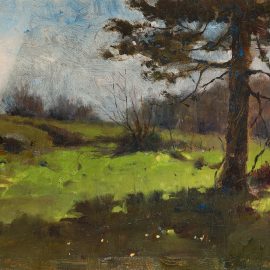Artist Biography
Using what Sarah Burn’s calls the nineteenth-century artist’s “transformative power of personal vision,” Luther Emerson Van Gorder created brilliant impressions of the French countryside, Parisian street scenes, and coasts along the Long Island Sound. During his lifetime, Van Gorder emerged as an important member of three major nineteenth-century art circles: William Merritt Chase’s New York School of Art; the American expatriate circuit in Paris, centered around the École des Beaux-Arts; and the Ohio School of Impressionism, all of which had a profound effect on his “personal vision.”
Born in Warren, Ohio, Van Gorder left for New York in 1885 to train
Using what Sarah Burn’s calls the nineteenth-century artist’s “transformative power of personal vision,” Luther Emerson Van Gorder created brilliant impressions of the French countryside, Parisian street scenes, and coasts along the Long Island Sound. During his lifetime, Van Gorder emerged as an important member of three major nineteenth-century art circles: William Merritt Chase’s New York School of Art; the American expatriate circuit in Paris, centered around the École des Beaux-Arts; and the Ohio School of Impressionism, all of which had a profound effect on his “personal vision.”
Born in Warren, Ohio, Van Gorder left for New York in 1885 to train under Charles Yardley Turner and William Merritt Chase at the Chase School of Art. After a trip to Europe in 1886, he became a frequent exhibitor at the National Academy of Design, the Pennsylvania Academy of the Fine Arts, and The Art Institute of Chicago. He made a second journey to Europe in 1894, remaining in Paris for five years. There, Van Gorder mastered academic painting techniques under Carolus-Duran (who also instructed John Singer Sargent) at the École des Beaux-Arts. He returned to New York in 1899 and settled in Toledo, Ohio in 1903, establishing himself as one of the state’s premier impressionists. Van Gorder was a member of several important art associations, including the Brooklyn Art Association, New York Watercolor Club, and Toledo Tile Club. His work is now featured in the Grand Rapids Art Museum; The Huntington Library, Art Collections, and Botanical Gardens; Toledo Museum of Art; Tweed Museum of Art, University of Minnesota Duluth; and Worcester Art Museum.
Van Gorder’s innovative technique combined the informal compositions featured by Chase and other impressionists, with the sophisticated realism of the French academics and the subtle color harmonies of tonalism. While his large-scale Parisian street scenes reflect an academic predilection for clearly delineated forms and orchestrated perspectives, his pastoral landscapes tend towards a more modern, impressionistic handling of composition. This is particularly visible in his picturesque vignettes of the French countryside; with high horizon lines, bird’s eye perspectives, and flattened treatments of space, the works suggest the influence of Japanese woodblock prints, which exerted a strong pull over the impressionists.
Using what Sarah Burn’s calls the nineteenth-century artist’s “transformative power of personal vision,” Luther Emerson Van Gorder created brilliant impressions of the French countryside, Parisian street scenes, and coasts along the Long Island Sound. During his lifetime, Van Gorder emerged as an important member of three major nineteenth-century art circles: William Merritt Chase’s New York School of Art; the American expatriate circuit in Paris, centered around the École des Beaux-Arts; and the Ohio School of Impressionism, all of which had a profound effect on his “personal vision.”
Born in Warren, Ohio, Van Gorder left for New York in 1885 to train under Charles Yardley Turner and William Merritt Chase at the Chase School of Art. After a trip to Europe in 1886, he became a frequent exhibitor at the National Academy of Design, the Pennsylvania Academy of the Fine Arts, and The Art Institute of Chicago. He made a second journey to Europe in 1894, remaining in Paris for five years. There, Van Gorder mastered academic painting techniques under Carolus-Duran (who also instructed John Singer Sargent) at the École des Beaux-Arts. He returned to New York in 1899 and settled in Toledo, Ohio in 1903, establishing himself as one of the state’s premier impressionists. Van Gorder was a member of several important art associations, including the Brooklyn Art Association, New York Watercolor Club, and Toledo Tile Club. His work is now featured in the Grand Rapids Art Museum; The Huntington Library, Art Collections, and Botanical Gardens; Toledo Museum of Art; Tweed Museum of Art, University of Minnesota Duluth; and Worcester Art Museum.
Van Gorder’s innovative technique combined the informal compositions featured by Chase and other impressionists, with the sophisticated realism of the French academics and the subtle color harmonies of tonalism. While his large-scale Parisian street scenes reflect an academic predilection for clearly delineated forms and orchestrated perspectives, his pastoral landscapes tend towards a more modern, impressionistic handling of composition. This is particularly visible in his picturesque vignettes of the French countryside; with high horizon lines, bird’s eye perspectives, and flattened treatments of space, the works suggest the influence of Japanese woodblock prints, which exerted a strong pull over the impressionists.

